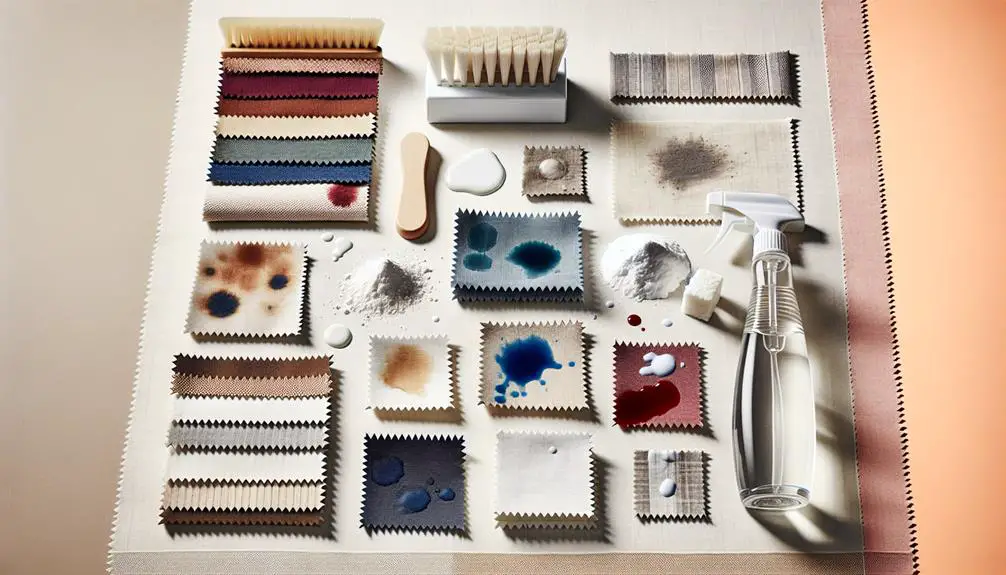Eliminating stains from different fabrics can be challenging, but with the right approach, you'll preserve your favorite items. You need to know specific techniques for each type of fabric to guarantee effective stain removal without causing damage. For instance, addressing a stubborn stain on cotton requires a different method than dealing with it on delicate silk or sturdy denim. Understanding these nuances can make all the difference. Have you ever wondered why some stains seem to vanish effortlessly while others linger despite your best efforts? Let's delve into the best practices for each fabric type, starting with the most common—cotton.
Table of Contents
Key Takeaways
- Act quickly to prevent stains from setting on any fabric.
- Blot stains with a clean cloth and use gentle cleaning solutions.
- Always test cleaning solutions on a small, hidden area first.
- Rinse the stained area thoroughly with cold water.
- Refer to fabric care labels and specific cleaning methods for best results.
Cotton
When dealing with stains on cotton, act promptly to prevent them from setting. The sooner you address the issue, the better your chances of complete stain removal. First, blot the stain gently with a clean cloth to absorb as much as possible. Avoid rubbing, as it can push the stain deeper into the fibers.
For effective cotton care, pre-treat the stained area with a stain remover or a mixture of water and laundry detergent. Let it sit for a few minutes but don't let it dry out.
Next, use cold water to rinse the stained area thoroughly. Hot water can set the stain, making it harder to remove. When it comes to fabric maintenance, always check the garment's care label before washing.
Wash the cotton item in the warmest water recommended for that fabric, adding a bit of extra detergent for stubborn stains. Avoid using bleach unless the cotton is white, as it can damage colored fabrics.
After washing, inspect the stain before drying. If the stain persists, repeat the process. Drying can set a stain permanently, so make sure it's completely gone before using the dryer.
Following these washing tips diligently will keep your cotton items looking pristine.
Silk
When you're dealing with stains on silk, you need to use gentle cleaning solutions to preserve the delicate fabric.
Make sure you follow proper drying techniques to avoid any watermarks or shrinkage.
Above all, take steps to prevent damage by acting quickly and cautiously.
Gentle Cleaning Solutions
For silk fabrics, opt for gentle cleaning solutions like a mixture of lukewarm water and mild detergent to avoid damage. Silk, being one of the most luxurious natural fibers, requires special care.
Create a homemade solution by blending a few drops of mild detergent or baby shampoo with lukewarm water. This mixture cleans effectively without harsh chemicals that can harm delicate materials.
Always test your solution on a small, inconspicuous area first. Dampen a clean cloth with the mixture, then gently blot the stain. Avoid rubbing, as it can cause fibers to break or create abrasion marks.
For eco-friendly options, consider using white vinegar or lemon juice diluted in water. These natural alternatives are gentle yet effective, preserving the integrity of your silk fabric.
After blotting the stain, rinse the area with cool water to remove any detergent residue. Use a clean, white cloth to dab away excess moisture. Remember, less is more when dealing with silk. Over-soaking or vigorous scrubbing can lead to irreversible damage.
Drying Techniques
How can you ensure your silk fabric dries without damage?
Start by embracing air drying as your preferred method. Silk is delicate, and heat setting can result in irreversible damage, including shrinkage and discoloration. After gently cleaning your silk piece, lay it flat on a clean, dry towel. Roll the towel with the silk inside to remove excess water, then unroll and lay the fabric flat to air dry. Make sure to keep it out of direct sunlight, which can fade the colors.
For best fabric care, resist the temptation to use a clothes dryer. The intense heat can weaken silk fibers, compromising the integrity of the fabric. Instead, let nature take its course. If you're concerned about wrinkles, wait until the silk is almost dry. At this stage, you can use a steam cleaning approach. Use a handheld steamer or the steam setting on your iron, keeping it at a safe distance to avoid direct contact. This method gently relaxes the fibers, smoothing out any creases without the harsh effects of heat setting.
Mastering these drying techniques ensures your silk remains luxurious, prolonging its elegance and lifespan.
Preventing Damage
To maintain the pristine appearance of your silk, always handle it with care to prevent snags and tears. The delicate quality of silk requires meticulous attention to fabric maintenance.
Start with stain prevention by acting promptly. If there's a spill, gently dab it with a clean cloth—never scrub. This helps soak up the liquid without pushing it further into the fibers.
For effective damage management, avoid prolonged exposure of your silk to direct sunlight. UV rays can weaken the material and fade its vivid colors. When storing silk, use padded hangers or fold it carefully in a breathable garment bag. This prevents strain on the fabric and shields it from dust and moths.
When it comes to fabric upkeep, always follow the care instructions. Wash silk by hand in lukewarm water with a gentle detergent, and avoid twisting it. Instead, roll the material in a towel to eliminate excess water. Refrain from using harsh chemicals or bleach, as they can cause irreversible damage to the material.
Opt for professional cleaning for heavily soiled or valuable silk items. This guarantees they receive the specialized care necessary to maintain their flawless condition, safeguarding their beauty and durability.
Wool
When dealing with wool, you'll want to use gentle cleaning methods to avoid damaging the fibers. Always avoid hot water and harsh scrubbing, which can cause shrinkage and felting.
After cleaning, lay the wool flat to dry, reshaping it to its original form to maintain its structure.
Gentle Cleaning Methods
Ever pondered the best way to treat a stubborn stain on your favorite wool sweater without causing harm? Wool is one of those delicate fabrics that necessitate special care during stain removal. Because wool is composed of natural fibers, spot cleaning is often the safest approach to maintain its integrity.
First, lay your sweater flat and gently blot the stain with a tidy cloth. Avoid rubbing, as it can stretch or harm the wool. Utilize a mild detergent mixed with lukewarm water to create a gentle cleaning solution. Moist another cloth with this mixture and pat the stain carefully. Rinse the area with cool water using a fresh cloth, then pat dry.
Here's a quick reference table to keep nearby:
| Stain Type | Cleaning Solution | Steps to Follow |
|---|---|---|
| Coffee/Tea | Mild detergent & lukewarm water | Blot, Pat with solution, Rinse |
| Red Wine | White vinegar & water | Blot, Pat with solution, Rinse |
| Grease/Oil | Cornstarch & mild detergent | Sprinkle cornstarch, Pat with solution, Rinse |
| Ink | Rubbing alcohol & water | Pat with solution, Rinse, Pat dry |
| Blood | Cold water & salt | Pat with solution, Rinse, Pat dry |
Employing these gentle cleaning methods guarantees your wool items remain fresh and unscathed.
Drying Techniques
Drying your wool garments correctly guarantees they retain their shape and softness. After washing, gently press out excess water without wringing to avoid stretching the fibers. Lay the item flat on a clean, dry towel, reshaping it to its original form. Roll the towel with the garment inside to absorb additional moisture. This preparation ensures your wool piece is ready for best air drying.
Air drying your wool garments is the gold standard. Lay them flat on a drying rack away from direct sunlight and heat sources. Make sure the drying area is well-ventilated to facilitate even drying and prevent mustiness. Check the garment periodically, reshaping as needed to maintain its form and prevent wrinkles. Patience here will reward you with beautifully preserved wool.
If you're considering machine drying, proceed with caution. Use a dryer with a wool or delicate setting on the lowest heat. Place the item in a mesh laundry bag to minimize agitation. Frequent checks are essential; remove the garment while it's still slightly damp, allowing it to finish air drying. This hybrid approach balances convenience with care, ensuring your wool retains its quality and longevity.
Denim
Denim stains can be stubborn, but with the right techniques, you'll have your favorite jeans looking fresh again in no time.
First, think about the type of stain you're dealing with. For oil-based stains, apply dish soap directly to the spot and let it sit for a few minutes before rinsing with cold water. For ink stains, rubbing alcohol or hand sanitizer can work wonders. Just dab it on and blot with a clean cloth until the stain lifts.
To maintain the integrity of your denim, consider eco-friendly dyeing methods. These not only reduce chemical use but also preserve the fabric's quality. If you're into DIY projects, try out some denim distressing techniques. These can give your jeans a trendy, worn-in look while you're working on stain removal.
For those who cherish their vintage pieces, mastering vintage denim restoration is key. You can also explore upcycling denim projects, turning old, stained jeans into something new and stylish.
Here's a quick checklist to get you started:
- For oil stains: Use dish soap and cold water.
- For ink stains: Apply rubbing alcohol.
- For vintage pieces: Focus on restoration and upcycling.
With these tips, your denim will look as good as new!
Upholstery
When it comes to upholstery, tackling stains quickly and effectively can save your furniture from lasting damage. Start by blotting the spill immediately with a clean, dry cloth. This prevents the liquid from seeping deeper into the fabric. For successful stain removal, always test your cleaning solution on a hidden area first to verify it won't harm the fabric.
Upholstery cleaning isn't just about stain removal; it's also about regular maintenance. Vacuum your furniture weekly to eliminate dust and debris, which can wear down the fabric over time. Using fabric protection sprays can add an extra layer of defense against future spills.
Here's a quick reference table for common stains and their remedies:
| Stain Type | Cleaning Solution |
|---|---|
| Coffee | Mix 1 tbsp vinegar with 2/3 cup rubbing alcohol |
| Grease | Sprinkle baking soda, then vacuum and blot with dish soap solution |
| Red Wine | Blot with club soda, then apply a mixture of dish soap and hydrogen peroxide |
| Ink | Dab with rubbing alcohol using a cotton swab |
| Pet Urine | Apply a mixture of vinegar and water, then sprinkle baking soda |
Linen
Dealing with stains on linen requires swift action to prevent them from setting. Start by blotting the stain with a clean cloth to absorb as much as possible. Avoid rubbing, as it can push the stain deeper into the fibers.
Next, apply a gentle detergent mixed with water to the stained area, using a soft brush to work it in lightly. Rinse thoroughly with cold water and repeat if necessary.
For the best linen care, follow these steps:
- Pre-treat stains immediately: The quicker you act, the easier the stain will lift.
- Use cold water: Hot water can set stains, making them almost impossible to remove.
- Gentle handling: Agitating linen too much can damage its delicate fibers.
When it comes to ironing tips, always iron linen when it's slightly damp for the most effective results. Use a hot iron with steam to smooth out wrinkles effectively.
For linen storage, avoid wrinkles by rolling your linens instead of folding them. Store them in a cool, dry place away from direct sunlight to maintain their quality.
Mastering linen care means understanding the nuances of stain removal, proper ironing techniques, and efficient storage methods. With these tips, your linen will stay beautiful and pristine for years to come.
Frequently Asked Questions
How Do You Remove Ink Stains From Synthetic Fabrics?
To tackle ink stain removal from synthetic fabrics, first blot the stain. Apply a DIY stain remover, like rubbing alcohol. Unlike cotton fabrics or silk garments, synthetic materials often respond well to this method.
What's the Best Way to Treat Blood Stains on Polyester?
Imagine a knight battling a dragon. First, douse the bloodstain with cold water and lemon juice. Then, release hydrogen peroxide and an enzyme cleaner. This heroic combo guarantees polyester emerges victorious, stain-free and pristine.
Can You Use Vinegar to Remove Stains From Nylon?
Yes, you can use vinegar to eliminate stains from nylon. However, vinegar alternatives like baking soda or hydrogen peroxide are also effective. Mastering stain removal techniques guarantees you can tackle any fabric stain challenge confidently.
How Do You Handle Oil Stains on Spandex Blends?
For oil stains on spandex blends, apply dish soap directly to the stain and gently rub. Unlike grease stains on silk fabrics or wine spills on cotton blends, spandex can withstand a thorough wash without damage.
What Products Are Safe for Stain Removal on Acetate Fabrics?
When considering acetate fabric care, always test stain removal techniques on a hidden area first. Use mild detergents, avoid bleach, and opt for products like white vinegar or rubbing alcohol to guarantee you don't damage the fabric.
- Tetron Fabric for Marine Applications: Durability and Use Cases - June 18, 2025
- Tetron Fabric for Outdoor Furniture: Weather Resistance and Care - June 18, 2025
- Tetron Fabric for Wall Coverings: Style and Application Tips - June 18, 2025




